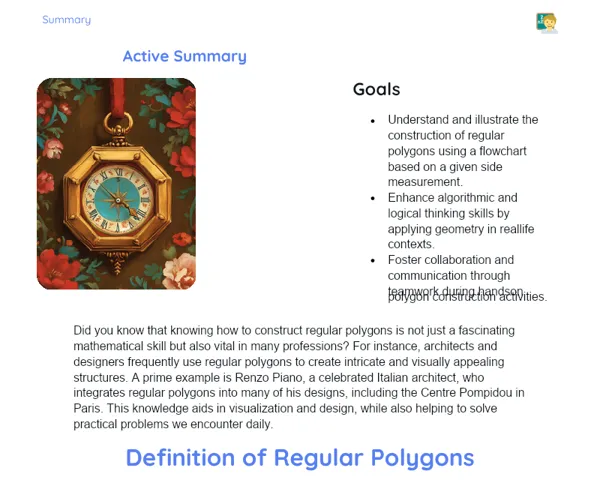Socioemotional Summary Conclusion
Goals
1. 👩🏫 Understand what a polynomial is and how its parts fit together.
2. 🔢 Learn to calculate the numerical value of a polynomial by plugging in a specific value for x.
3. 🔍 Enhance problem-solving skills in mathematics.
4. 🙂 Build emotional resilience and self-regulation when tackling academic challenges.
Contextualization
🌉 Did you know that polynomials play a role in many aspects of our everyday life? Be it in designing bridges, planning roadways, or even forecasting weather during the monsoon, these mathematical expressions are key to solving intricate problems and making informed decisions. Mastering how to compute the numerical value of polynomials not only strengthens your math skills but also boosts your ability to handle challenges gracefully – a skill that is very much needed in our day-to-day lives in India! 🚀
Exercising Your Knowledge
Definition of Polynomials
Polynomials are algebraic expressions that are built from variables, coefficients, and operations like addition, subtraction, and multiplication. They form a fundamental part of mathematics and appear in various contexts, from school textbooks to real-life engineering problems. Getting a clear idea about their structure is essential as you progress to more advanced topics.
-
🔹 Terms: Each part of a polynomial is called a term. For instance, in 2x^3 - 4x^2 + x - 7, the term 2x^3 stands on its own.
-
🔹 Coefficients: These are the numbers multiplying the variables. For example, in 3x^2, 3 is the coefficient.
-
🔹 Variables: Usually represented by letters like x, these can take on different values depending on the problem.
-
🔹 Exponents: They show the power to which the variable is raised. For example, in x^3, 3 is the exponent.
Degree of a Polynomial
The degree of a polynomial is determined by the highest exponent of the variable in its terms. It helps you understand the complexity of the polynomial and is often a factor in solving polynomial equations.
-
🔹 Identifying the Degree: To determine the degree, look for the term with the highest exponent. For instance, in 4x^3 + 2x^2 - x + 1, the degree is 3.
-
🔹 Relevance: The degree gives insights into the polynomial's behavior on a graph and influences the nature of its solutions.
Numerical Value of a Polynomial
Finding the numerical value of a polynomial means replacing the variable with a given number and then performing the required calculations. This skill is not only useful for academic purposes but also for solving practical problems in fields like engineering, economics, and even day-to-day scenarios.
-
🔹 Substitution: Replace the variable (x) with a specific number. For example, for P(x) = x^2 + 2x + 1, if x = 3 then P(3) = 3^2 + 2(3) + 1 = 16.
-
🔹 Calculation: Carry out the operations as indicated by the polynomial’s terms.
-
🔹 Applicability: This technique is widely applied in areas such as civil engineering, physics, and even financial calculations to make predictions and decisions.
Key Terms
-
📘 Polynomial: An algebraic expression made up of variables, coefficients, and mathematical operations.
-
📘 Terms: The individual parts of a polynomial, such as 2x^3.
-
📘 Coefficient: The number multiplying the variable in a term, for example, 3 in 3x^2.
-
📘 Variable: A symbol, typically a letter, that represents a value which can change.
-
📘 Exponent: Indicates the power to which the variable is raised, such as 2 in x^2.
-
📘 Degree: Refers to the highest exponent in a polynomial.
For Reflection
-
🤔 Reflection 1: How can understanding polynomials help you solve everyday problems, such as planning expenses or organizing a trip across town?
-
🤔 Reflection 2: What emotions did you experience when tackling math challenges today, and how did you manage them? Reflect on how these feelings influenced your performance.
-
🤔 Reflection 3: Think of an instance outside school where you had to make an important decision. How might the skill of calculating the value of a polynomial have been useful in that situation?
Important Conclusions
-
📌 Polynomials are algebraic expressions consisting of terms, coefficients, variables, and exponents.
-
📌 The numerical value of a polynomial is obtained by substituting x with a specific number.
-
📌 Mastery of polynomials is crucial for addressing many practical problems across disciplines like engineering and economics.
-
📌 Alongside mathematical proficiency, developing socio-emotional skills such as self-awareness and regulation helps build confidence in facing academic challenges.
Impacts on Society
🌍 Impact on Society: Polynomials are at the heart of many processes – from designing safe and sturdy structures in civil engineering to accurately forecasting weather patterns crucial for our agricultural sector. A solid grasp of these concepts ensures we contribute towards the building of a secure and efficient society. In our daily lives, the use of polynomials can help us make smarter decisions, be it in managing finances or planning for unexpected events.
💖 Emotional Connection: Working with polynomials also offers lessons in life. As you solve complex problems, you learn patience, discipline, and resilience. These skills not only help in academic success but also prepare you to handle stressful situations with calm and determination.
Dealing with Emotions
🧘🏽♂️ RULER Exercise: Take a few moments at home to reflect on your emotions during today's lesson. Begin by Recognizing your feelings – did you feel upset, confused, or proud of a new discovery? Understand the root cause of these emotions – was it the complexity of the topic or perhaps a fruitful discussion with a classmate? Name these emotions clearly. Next, consider how you expressed your feelings. Were you able to communicate them effectively? Finally, think about ways to regulate these emotions to stay calm and focused in future challenges. Jot down your reflections in a journal to help track your progress.
Study Tips
-
📚 Daily Review: Recap your class notes every day. Brief, regular revisions help cement the concepts in long-term memory.
-
🤝 Group Study: Form study groups with friends or classmates. Discussing problems together can clear doubts and deepen your understanding.
-
🧩 Practical Application: Try to apply the concepts of polynomials to real-life situations. This makes learning more engaging and relevant!



